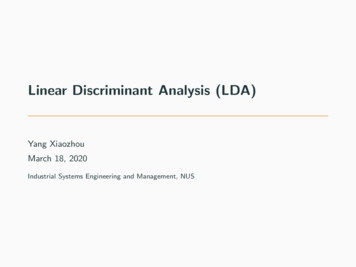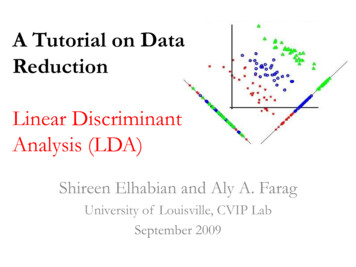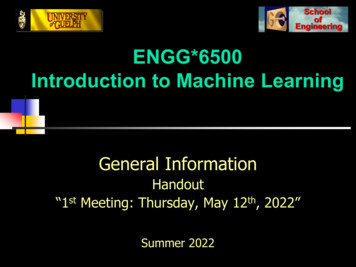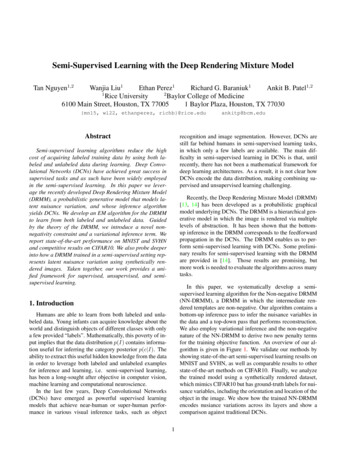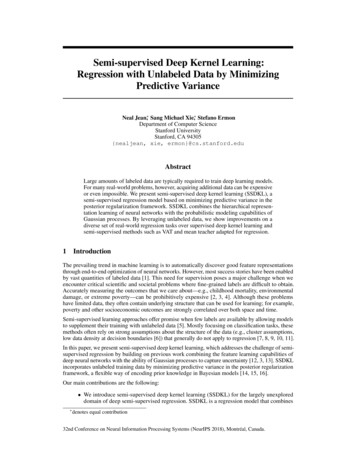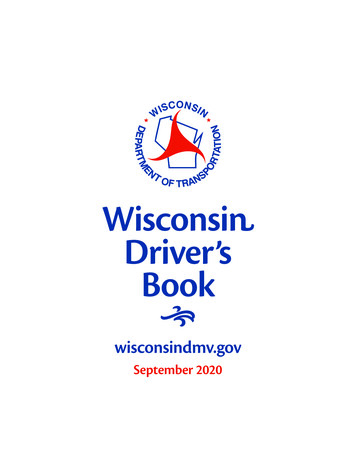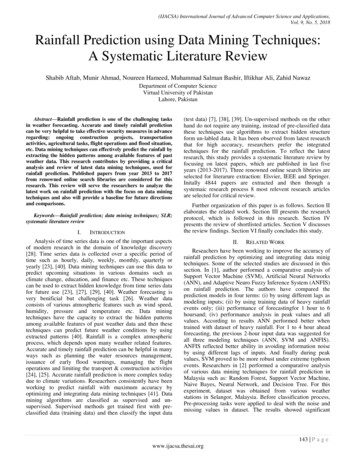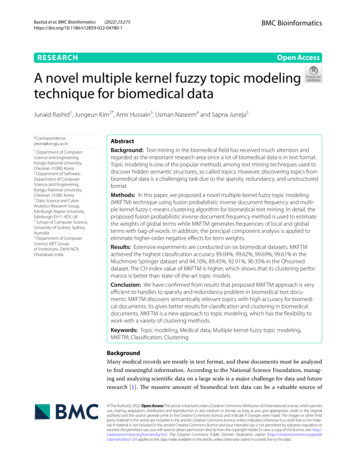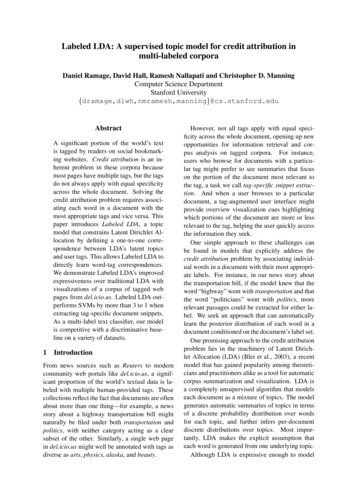
Transcription
Labeled LDA: A supervised topic model for credit attribution inmulti-labeled corporaDaniel Ramage, David Hall, Ramesh Nallapati and Christopher D. ManningComputer Science DepartmentStanford ord.eduAbstractA significant portion of the world’s textis tagged by readers on social bookmarking websites. Credit attribution is an inherent problem in these corpora becausemost pages have multiple tags, but the tagsdo not always apply with equal specificityacross the whole document. Solving thecredit attribution problem requires associating each word in a document with themost appropriate tags and vice versa. Thispaper introduces Labeled LDA, a topicmodel that constrains Latent Dirichlet Allocation by defining a one-to-one correspondence between LDA’s latent topicsand user tags. This allows Labeled LDA todirectly learn word-tag correspondences.We demonstrate Labeled LDA’s improvedexpressiveness over traditional LDA withvisualizations of a corpus of tagged webpages from del.icio.us. Labeled LDA outperforms SVMs by more than 3 to 1 whenextracting tag-specific document snippets.As a multi-label text classifier, our modelis competitive with a discriminative baseline on a variety of datasets.1IntroductionFrom news sources such as Reuters to moderncommunity web portals like del.icio.us, a significant proportion of the world’s textual data is labeled with multiple human-provided tags. Thesecollections reflect the fact that documents are oftenabout more than one thing—for example, a newsstory about a highway transportation bill mightnaturally be filed under both transportation andpolitics, with neither category acting as a clearsubset of the other. Similarly, a single web pagein del.icio.us might well be annotated with tags asdiverse as arts, physics, alaska, and beauty.However, not all tags apply with equal specificity across the whole document, opening up newopportunities for information retrieval and corpus analysis on tagged corpora. For instance,users who browse for documents with a particular tag might prefer to see summaries that focuson the portion of the document most relevant tothe tag, a task we call tag-specific snippet extraction. And when a user browses to a particulardocument, a tag-augmented user interface mightprovide overview visualization cues highlightingwhich portions of the document are more or lessrelevant to the tag, helping the user quickly accessthe information they seek.One simple approach to these challenges canbe found in models that explicitly address thecredit attribution problem by associating individual words in a document with their most appropriate labels. For instance, in our news story aboutthe transportation bill, if the model knew that theword “highway” went with transportation and thatthe word “politicians” went with politics, morerelevant passages could be extracted for either label. We seek an approach that can automaticallylearn the posterior distribution of each word in adocument conditioned on the document’s label set.One promising approach to the credit attributionproblem lies in the machinery of Latent Dirichlet Allocation (LDA) (Blei et al., 2003), a recentmodel that has gained popularity among theoreticians and practitioners alike as a tool for automaticcorpus summarization and visualization. LDA isa completely unsupervised algorithm that modelseach document as a mixture of topics. The modelgenerates automatic summaries of topics in termsof a discrete probability distribution over wordsfor each topic, and further infers per-documentdiscrete distributions over topics. Most importantly, LDA makes the explicit assumption thateach word is generated from one underlying topic.Although LDA is expressive enough to model
multiple topics per document, it is not appropriatefor multi-labeled corpora because, as an unsupervised model, it offers no obvious way of incorporating a supervised label set into its learning procedure. In particular, LDA often learns some topicsthat are hard to interpret, and the model providesno tools for tuning the generated topics to suit anend-use application, even when time and resourcesexist to provide some document labels.Several modifications of LDA to incorporatesupervision have been proposed in the literature.Two such models, Supervised LDA (Blei andMcAuliffe, 2007) and DiscLDA (Lacoste-Julienet al., 2008) are inappropriate for multiply labeledcorpora because they limit a document to being associated with only a single label. Supervised LDAposits that a label is generated from each document’s empirical topic mixture distribution. DiscLDA associates a single categorical label variablewith each document and associates a topic mixturewith each label. A third model, MM-LDA (Ramage et al., 2009), is not constrained to one labelper document because it models each document asa bag of words with a bag of labels, with topics foreach observation drawn from a shared topic distribution. But, like the other models, MM-LDA’slearned topics do not correspond directly with thelabel set. Consequently, these models fall short asa solution to the credit attribution problem. Because labels have meaning to the people that assigned them, a simple solution to the credit attribution problem is to assign a document’s words toits labels rather than to a latent and possibly lessinterpretable semantic space.This paper presents Labeled LDA (L-LDA), agenerative model for multiply labeled corpora thatmarries the multi-label supervision common tomodern text datasets with the word-assignmentambiguity resolution of the LDA family of models. In contrast to standard LDA and its existingsupervised variants, our model associates each label with one topic in direct correspondence. In thefollowing section, L-LDA is shown to be a natural extension of both LDA (by incorporating supervision) and Multinomial Naive Bayes (by incorporating a mixture model). We demonstratethat L-LDA can go a long way toward solving thecredit attribution problem in multiply labeled documents with improved interpretability over LDA(Section 4). We show that L-LDA’s credit attribution ability enables it to greatly outperform sup-βαθΦΛzwwNKDηFigure 1: Graphical model of Labeled LDA: unlike standard LDA, both the label set Λ as well asthe topic prior α influence the topic mixture θ.port vector machines on a tag-driven snippet extraction task on web pages from del.icio.us (Section 6). And despite its generative semantics,we show that Labeled LDA is competitive witha strong baseline discriminative classifier on twomulti-label text classification tasks (Section 7).2Labeled LDALabeled LDA is a probabilistic graphical modelthat describes a process for generating a labeleddocument collection. Like Latent Dirichlet Allocation, Labeled LDA models each document as amixture of underlying topics and generates eachword from one topic. Unlike LDA, L-LDA incorporates supervision by simply constraining thetopic model to use only those topics that correspond to a document’s (observed) label set. Themodel description that follows assumes the readeris familiar with the basic LDA model (Blei et al.,2003).Let each document d be represented by a tuple consisting of a list of word indices w(d) (w1 , . . . , wNd ) and a list of binary topic presence/absence indicators Λ(d) (l1 , . . . , lK )where each wi {1, . . . , V } and each lk {0, 1}.Here Nd is the document length, V is the vocabulary size and K the total number of unique labelsin the corpus.We set the number of topics in Labeled LDA tobe the number of unique labels K in the corpus.The generative process for the algorithm is foundin Table 1. Steps 1 and 2—drawing the multinomial topic distributions over vocabulary β k foreach topic k, from a Dirichlet prior η—remainthe same as for traditional LDA (see (Blei et al.,2003), page 4). The traditional LDA model thendraws a multinomial mixture distribution θ (d) overall K topics, for each document d, from a Dirichletprior α. However, we would like to restrict θ (d) tobe defined only over the topics that correspond to
1 For each topic k {1, . . . , K}:2Generate β k (βk,1 , . . . , βk,V )T Dir(· η)3 For each document d:4For each topic k {1, . . . , K}(d)5Generate Λk {0, 1} Bernoulli(· Φk )6Generate α(d) L(d) α7Generate θ (d) (θl1 , . . . , θlMd )T Dir(· α(d) )8For each i in {1, . . . , Nd }:(d)(d)9Generate zi {λ1 , . . . , λMd } Mult(· θ (d) )10Generate wi {1, . . . , V } Mult(· β zi )Table 1: Generative process for Labeled LDA:β k is a vector consisting of the parameters of themultinomial distribution corresponding to the k thtopic, α are the parameters of the Dirichlet topicprior and η are the parameters of the word prior,while Φk is the label prior for topic k. For themeaning of the projection matrix L(d) , please refer to Eq 1.its labels Λ(d) . Since the word-topic assignmentszi (see step 9 in Table 1) are drawn from this distribution, this restriction ensures that all the topicassignments are limited to the document’s labels.Towards this objective, we first generate thedocument’s labels Λ(d) using a Bernoulli coin tossfor each topic k, with a labeling prior probabilityΦk , as shown in step 5. Next, we define the vector(d)of document’s labels to be λ(d) {k Λk 1}.This allows us to define a document-specific label projection matrix L(d) of size Md K foreach document d, where Md λ(d) , as follows: For each row i {1, . . . , Md } and columnj {1, . . . , K} :((d)1 if λi j(d)Lij (1)0 otherwise.In other words, the ith row of L(d) has an entry of1 in column j if and only if the ith document label(d)λi is equal to the topic j, and zero otherwise.As the name indicates, we use the L(d) matrix toproject the parameter vector of the Dirichlet topicprior α (α1 , . . . , αK )T to a lower dimensionalvector α(d) as follows:α(d) L(d) α (αλ(d) , . . . , αλ(d) )T1(2)MdClearly, the dimensions of the projected vectorcorrespond to the topics represented by the labelsof the document. For example, suppose K 4and that a document d has labels given by Λ(d) {0, 1, 1, 0} which implies λ(d) {2, 3}, then L(d)would be: 0 1 0 00 0 1 0 .Then, θ (d) is drawn from a Dirichlet distributionwith parameters α(d) L(d) α (α2 , α3 )T(i.e., with the Dirichlet restricted to the topics 2and 3).This fulfills our requirement that the document’s topics are restricted to its own labels. Theprojection step constitutes the deterministic step6 in Table 1. The remaining part of the modelfrom steps 7 through 10 are the same as for regular LDA.The dependency of θ on both α and Λ is indicated by directed edges from Λ and α to θ inthe plate notation in Figure 1. This is the only additional dependency we introduce in LDA’s representation (please compare with Figure 1 in (Blei etal., 2003)).2.1Learning and inferenceIn most applications discussed in this paper, wewill assume that the documents are multiplytagged with human labels, both at learning and inference time.When the labels Λ(d) of the document are observed, the labeling prior Φ is d-separated fromthe rest of the model given Λ(d) . Hence the modelis same as traditional LDA, except the constraintthat the topic prior α(d) is now restricted to theset of labeled topics λ(d) . Therefore, we can usecollapsed Gibbs sampling (Griffiths and Steyvers,2004) for training where the sampling probabilityfor a topic for position i in a document d in Labeled LDA is given by:P (zi j z i ) inw i,j ηwi(·)n i,j η T 1(d) n i,j αj(d)n i,· αT 1(3)wiwhere n i,j is the count of word wi in topic j, thatdoes not include the current assignment zi , a miss(·)ing subscript or superscript (e.g. n i,j )) indicatesa summation over that dimension, and 1 is a vectorof 1’s of appropriate dimension.Although the equation above looks exactly thesame as that of LDA, we have an important distinction in that, the target topic j is restricted tobelong to the set of labels, i.e., j λ(d) .Once the topic multinomials β are learned fromthe training set, one can perform inference on anynew labeled test document using Gibbs sampling
restricted to its tags, to determine its per-word label assignments z. In addition, one can also compute its posterior distribution θ over topics by appropriately normalizing the topic assignments z.It should now be apparent to the reader howthe new model addresses some of the problems inmulti-labeled corpora that we highlighted in Section 1. For example, since there is a one-to-onecorrespondence between the labels and topics, themodel can display automatic topical summariesfor each label k in terms of the topic-specific distribution β k . Similarly, since the model assigns alabel zi to each word wi in the document d automatically, we can now extract portions of thedocument relevant to each label k (it would be allwords wi w(d) such that zi k). In addition,we can use the topic distribution θ (d) to rank theuser specified labels in the order of their relevanceto the document, thereby also eliminating spuriousones if necessary.Finally, we note that other less restrictive variants of the proposed L-LDA model are possible.For example, one could consider a version thatallows topics that do not correspond to the labelset of a given document with a small probability,or one that allows a common background topic inall documents. We did implement these variantsin our preliminary experiments, but they did notyield better performance than L-LDA in the taskswe considered. Hence we do not report them inthis paper.2.2Relationship to Naive BayesThe derivation of the algorithm so far has focused on its relationship to LDA. However, Labeled LDA can also be seen as an extension ofthe event model of a traditional Multinomial NaiveBayes classifier (McCallum and Nigam, 1998) bythe introduction of a mixture model. In this section, we develop the analogy as another way tounderstand L-LDA from a supervised perspective.Consider the case where no document in thecollection is assigned two or more labels. Nowfor a particular document d with label ld , LabeledLDA draws each word’s topic variable zi from amultinomial constrained to the document’s labelset, i.e. zi ld for each word position i in the document. During learning, the Gibbs sampler willassign each zi to ld while incrementing βld (wi ),effectively counting the occurences of each wordtype in documents labeled with ld . Thus in thesingly labeled document case, the probability ofeach document under Labeled LDA is equal tothe probability of the document under the Multinomial Naive Bayes event model trained on thosesame document instances. Unlike the Multinomial Naive Bayes classifier, Labeled LDA doesnot encode a decision boundary for unlabeled documents by comparing P (w(d) ld ) to P (w(d) ld ),although we discuss using Labeled LDA for multilabel classification in Section 7.Labeled LDA’s similarity to Naive Bayes endswith the introduction of a second label to any document. In a traditional one-versus-rest Multinomial Naive Bayes model, a separate classifier foreach label would be trained on all documents withthat label, so each word can contribute a countof 1 to every observed label’s word distribution.By contrast, Labeled LDA assumes that each document is a mixture of underlying topics, so thecount mass of single word instance must instead bedistributed over the document’s observed labels.3Credit attribution within taggeddocumentsSocial bookmarking websites contain millions oftags describing many of the web’s most popular and useful pages. However, not all tags areuniformly appropriate at all places within a document. In the sections that follow, we examinemechanisms by which Labeled LDA’s credit assignment mechanism can be utilized to help support browsing and summarizing tagged documentcollections.To create a consistent dataset for experimentingwith our model, we selected 20 tags of mediumto high frequency from a collection of documentsdataset crawled from del.icio.us, a popular social bookmarking website (Heymann et al., 2008).From that larger dataset, we selected uniformly atrandom four thousand documents that containedat least one of the 20 tags, and then filtered eachdocument’s tag set by removing tags not presentin our tag set. After filtering, the resulting corpus averaged 781 non-stop words per document,with each document having 4 distinct tags on average. In contrast to many existing text datasets, ourtagged corpus is highly multiply labeled: almost90% of of the documents have more than one tag.(For comparison, less than one third of the newsdocuments in the popular RCV1-v2 collection ofnewswire are multiply labeled). We will refer to
this collection of data as the del.icio.us tag dataset.4Topic VisualizationA first question we ask of Labeled LDA is how itstopics compare with those learned by traditionalLDA on the same collection of documents. We ranour implementations of Labeled LDA and LDAon the del.icio.us corpus described above. Bothare based on the standard collapsed Gibbs sampler, with the constraints for Labeled LDA implemented as in Section 2.webcomments read nice post greatapril blog march june wordpressbooksbook image pdf review libraryposted read copyright books titlenews information service web on- 13line project site free search homescienceworks water map human life workscience time world years sleepweb images design content javacss website articles page learning19religion computerwindows file version linux computer free system software macjun quote pro views added checkanonymous card core power ghz4comment god jesus people gospelbible reply lord religion writtenlife written jesus words made mancalled mark john person fact name3java(LDA) Topic IDweb search site blog css contentgoogle list page posted great workapplications spring open web javapattern eclipse development ajaxhouse light radio media photography news music travel cover2cultureTag (Labeled LDA)people day link posted time comments back music jane permalinkgame review street public arthealth food city history science12The Elements of Style, William Strunk, Jr.Asserting that one must first know the rules to break them, thisclassic reference book is a must-have for any student andconscientious writer. Intended for use in which the practice ofcomposition is combined with the study of literature, it gives inbrief space the principal requirements of plain English style andconcentrates attention on the rules of usage and principles ofcomposition most commonly violated.Figure 3: Example document with importantwords annotated with four of the page’s tags aslearned by Labeled LDA. Red (single underline)is style, green (dashed underline) grammar, blue(double underline) reference, and black (jaggedunderline) education.8Figure 2: Comparison of some of the 20 topicslearned on del.icio.us by Labeled LDA (left) andtraditional LDA (right), with representative wordsfor each topic shown in the boxes. Labeled LDA’stopics are named by their associated tag. Arrowsfrom right-to-left show the mapping of LDA topicsto the closest Labeled LDA topic by cosine similarity. Tags not shown are: design, education, english, grammar, history, internet, language, philosophy, politics, programming, reference, style,writing.Figure 2 shows the top words associated with20 topics learned by Labeled LDA and 20 topicslearned by unsupervised LDA on the del.icio.usdocument collection. Labeled LDA’s topics aredirectly named with the tag that corresponds toeach topic, an improvement over standard practice of inferring the topic name by inspection (Meiet al., 2007). The topics learned by the unsupervised variant were matched to a Labeled LDAtopic highest cosine similarity.The topics selected are representative: compared to Labeled LDA, unmodified LDA allocatesmany topics for describing the largest parts of thecorpus and under-represents tags that are less uncommon: of the 20 topics learned, LDA learnedmultiple topics mapping to each of five tags (web,culture, and computer, reference, and politics, allof which were common in the dataset) and learnedno topics that aligned with six tags (books, english,science, history, grammar, java, and philosophy,which were rarer).5Tagged document visualizationIn addition to providing automatic summaries ofthe words best associated with each tag in the corpus, Labeled LDA’s credit attribution mechanismcan be used to augment the view of a single document with rich contextual information about thedocument’s tags.Figure 3 shows one web document from the collection, a page describing a guide to writing English prose. The 10 most common tags for thatdocument are writing, reference, english, grammar, style, language, books, book, strunk, and education, the first eight of which were included inour set of 20 tags. In the figure, each word that hashigh posterior probability from one tag has beenannotated with that tag. The red words come fromthe style tag, green from the grammar tag, bluefrom the reference tag, and black from the education tag. In this case, the model does very well atassigning individual words to the tags that, subjectively, seem to strongly imply the presence of thattag on this page. A more polished rendering couldadd subtle visual cues about which parts of a pageare most appropriate for a particular set of tags.
booksL-LDA this classic reference book is a must-have for anystudent and conscientious writer. Intended forModelL-LDASVMBest Snippet72 / 14921 / 149Unanimous24 / 512 / 51SVM the rules of usage and principles of compositionmost commonly violated. Search: CONTENTS BibliographiclanguageL-LDA the beginning of a sentence must refer to the grammatical subject 8. Divide words atSVM combined with the study of literature, it gives in briefspace the principal requirements ofgrammarL-LDA requirements of plain English style and concentrates attention on the rules of usage and principles ofSVM them, this classic reference book is a must-have forany student and conscientious writer.Figure 4: Representative snippets extracted byL-LDA and tag-specific SVMs for the web pageshown in Figure 3.6Snippet ExtractionAnother natural application of Labeled LDA’scredit assignment mechanism is as a means of selecting snippets of a document that best describeits contents from the perspective of a particulartag. Consider again the document in Figure 3. Intuitively, if this document were shown to a userinterested in the tag grammar, the most appropriate snippet of words might prefer to contain thephrase “rules of usage,” whereas a user interestedin the term style might prefer the title “Elementsof Style.”To quantitatively evaluate Labeled LDA’s performance at this task, we constructed a set of 29recently tagged documents from del.icio.us thatwere labeled with two or more tags from the 20 tagsubset, resulting in a total of 149 (document,tag)pairs. For each pair, we extracted a 15-word window with the highest tag-specific score from thedocument. Two systems were used to score eachwindow: Labeled LDA and a collection of onevs-rest SVMs trained for each tag in the system.L-LDA scored each window as the expected probability that the tag had generated each word. ForSVMs, each window was taken as its own document and scored using the tag-specific SVM’sun-thresholded scoring function, taking the window with the most positive score. While a complete solution to the tag-specific snippet extractionTable 2: Human judgments of tag-specific snippetquality as extracted by L-LDA and SVM. The center column is the number of document-tag pairs forwhich a system’s snippet was judged superior. Theright column is the number of snippets for whichall three annotators were in complete agreement(numerator) in the subset of document scored byall three annotators (denominator).problem might be more informed by better linguistic features (such as phrase boundaries), thisexperimental setup suffices to evaluate both kindsof models for their ability to appropriately assignwords to underlying labels.Figure 3 shows some example snippets outputby our system for this document. Note that whileSVMs did manage to select snippets that werevaguely on topic, Labeled LDA’s outputs are generally of superior subjective quality. To quantifythis intuition, three human annotators rated eachpair of snippets. The outputs were randomly labeled as “System A” or “System B,” and the annotators were asked to judge which system generateda better tag-specific document subset. The judgeswere also allowed to select neither system if therewas no clear winner. The results are summarizedin Table 2.L-LDA was judged superior by a wide margin:of the 149 judgments, L-LDA’s output was selected as preferable in 72 cases, whereas SVM’swas selected in only 21. The difference betweenthese scores was highly significant (p .001) bythe sign test. To quantify the reliability of the judgments, 51 of the 149 document-tag pairs were labeled by all three annotators. In this group, thejudgments were in substantial agreement,1 withFleiss’ Kappa at .63.Further analysis of the triply-annotated subset yields further evidence of L-LDA’s advantageover SVM’s: 33 of the 51 were tag-page pairswhere L-LDA’s output was picked by at least oneannotator as a better snippet (although L-LDAmight not have been picked by the other annotators). And of those, 24 were unanimous in that1Of the 15 judgments that were in contention, only twoconflicted on which system was superior (L-LDA versusSVM); the remaining disagreements were about whether ornot one of the systems was a clear winner.
all three judges selected L-LDA’s output. By contrast, only 10 of the 51 were tag-page pairs whereSVMs’ output was picked by at least one annotator, and of those, only 2 were selected unanimously.7Multilabeled Text ClassificationIn the preceding section we demonstrated how Labeled LDA’s credit attribution mechanism enabledeffective modeling within documents. In this section, we consider whether L-LDA can be adaptedas an effective multi-label classifier for documentsas a whole. To answer that question, we applieda modified variant of L-LDA to a multi-label document classification problem: given a training setconsisting of documents with multiple labels, predict the set of labels appropriate for each document in a test set.Multi-label classification is a well researchedproblem. Many modern approaches incorporatelabel correlations (e.g., Kazawa et al. (2004), Jiet al. (2008)). Others, like our algorithm arebased on mixture models (such as Ueda and Saito(2003)). However, we are aware of no methodsthat trade off label-specific word distributions withdocument-specific label distributions in quite thesame way.In Section 2, we discussed learning and inference when labels are observed. In the task of multilabel classification, labels are available at training time, so the learning part remains the same asdiscussed before. However, inferring the best setof labels for an unlabeled document at test time ismore complex: it involves assessing all label assignments and returning the assignment that hasthe highest posterior probability. However, thisis not straight-forward, since there are 2K possible label assignments. To make matters worse, thesupport of α(Λ(d) ) is different for different labelassignments. Although we are in the process ofdeveloping an efficient sampling algorithm for thisinference, for the purposes of this paper we makethe simplifying assumption that the model reducesto standard LDA at inference, where the documentis free to sample from any of the K topics. Thisis a reasonable assumption because allowing themodel to explore the whole topic space for eachdocument is similar to exploring all possible labelassignments. The document’s most likely labelscan then be inferred by suitably thresholding itsposterior probability over topics.As a baseline, we use a set of multiple one-vsrest SVM classifiers which is a popular and extremely competitive baseline used by most previous papers (see (Kazawa et al., 2004; Ueda andSaito, 2003) for instance). We scored each modelbased on Micro-F1 and Macro-F1 as our evaluation measures (Lewis et al., 2004). While the former allows larger classes to dominate its results,the latter assigns an equal weight to all classes,providing us complementary information.7.1YahooWe ran experiments on a corpus from the Yahoodirectory, modeling our experimental conditionson the ones described in (Ji et al., 2008).2 Weconsidered documents drawn from 8 top level categories in the Yahoo directory, where each document can be placed in any number of subcategories. The results were mixed, with SVMs aheadon one measure: Labeled LDA beat SVMs on fiveout of eight datasets on MacroF1, but didn’t winon any datasets on MicroF1. Results are presentedin Table 3.Because only a processed form of the documents was released, the Yahoo dataset does notlend itself well to error analysis. However, only33% of the documents in each top-level categorywere applied to more than one sub-category, so thecredit assignment machinery of L-LDA was unused for the majority of documents. We therefore ran an artificial second set of experimentsconsidering only those documents that had beengiven more than one label in the training data. Onthese documents, the results were again mixed, butLabeled LDA comes out ahead. For MacroF1,L-LDA beat SVMs on four datasets, SVMs beatL-LDA on one dataset, and three were a statisticaltie.3 On MicroF1, L-LDA did much better than onthe larger subset, outperforming on four datasetswith the other four a statistical tie.It is worth noting that the Yahoo datasets areskewed by construction to contain many documents with highly overlapping content: becauseeach collection is within the same super-class suchas “Arts”, “Business”, etc., each sub-categories’2We did not carefully tune per-class thresholds of each ofthe one vs. rest classifiers in each model, but instead tunedonly one threshold for all classifiers in each model via crossv
vised model, it offers no obvious way of incorpo-rating a supervised label set into its learning proce-dure. In particular, LDA often learns some topics that are hard to interpret, and the model provides no tools for tuning the generated topics to suit an end-use application, even when time and resources exist to provide some document labels.
